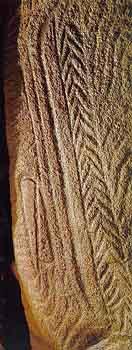- Home
- Megalithism in Morbihan
- Gavrinis
- Decoration
- Possible interpretations
Observation reveals a certain logic in the decorative patterns:
- the casual visitor will not be able to make out anything as the passage lies in darkness, even though it is visible from outside;
- the first, quite simple motifs, may be easy to interpret for visitors with an elementary knowledge of Neolithic mythology;
- the front part of pillar 24, jutting out half way along the passage, can just be made out from the entrance. It displays a set of weapons, as if to serve as a symbolic deterrent;
- the next pillars display more complex patterns, requiring a greater degree of initiation (probably even for the Neolithic visitors);
- finally, the visitor enters the chamber with its disconcerting atmosphere, by stepping over (or stepping on) the highly significant sill decoration.
Only excavation could have provided evidence supporting this interpretation, i.e. that the passage marks an initiatory journey through some kind of exceptional architectural experience. The projecting part of pillar 24: a bow and its two arrows between two axe heads and a probable wicker quiver.
The projecting part of pillar 24: a bow and its two arrows between two axe heads and a probable wicker quiver.
